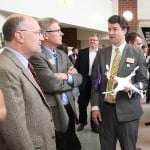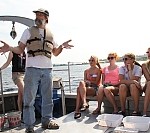 Ali Catik, president, Civil East Operations, Tutor Perini Corp, NY, and a 1976 Michigan Tech graduate presented the Civil Engineering Graduate Seminar entitled: “Civil and Environmental Engineering Mega Projects in Big Cities” on Friday, Sept. 27, in Dow 642. Watch the seminar presentation on Michigan Tech Engineering Channel on Vimeo
Ali Catik, president, Civil East Operations, Tutor Perini Corp, NY, and a 1976 Michigan Tech graduate presented the Civil Engineering Graduate Seminar entitled: “Civil and Environmental Engineering Mega Projects in Big Cities” on Friday, Sept. 27, in Dow 642. Watch the seminar presentation on Michigan Tech Engineering Channel on Vimeo
 The staff of the Michigan Tech Research Institute (MTRI) in Ann Arbor was on campus on Friday, Sept. 20, to conduct a poster session in the Dow Atrium (sixth-floor campus entrance). MTRI scientists and engineers were also available to discuss projects, collaborations with Michigan Tech departments and staff, and areas of research interest. The session is intended to outline the institute’s current activities and to explore opportunities to develop new working relationships.
The staff of the Michigan Tech Research Institute (MTRI) in Ann Arbor was on campus on Friday, Sept. 20, to conduct a poster session in the Dow Atrium (sixth-floor campus entrance). MTRI scientists and engineers were also available to discuss projects, collaborations with Michigan Tech departments and staff, and areas of research interest. The session is intended to outline the institute’s current activities and to explore opportunities to develop new working relationships.
MTRI, a research center of Michigan Technological University, is a recognized leader in the research, development and practical application of sensor and information technology to solve critical problems in national security, protecting and evaluating critical infrastructure, bioinformatics, earth sciences and environmental processes.
 Frank C. Townsend, PhD., P.E., a 1962 graduate of Michigan Tech, delivered a Civil Engineering Graduate Seminar entitled “Panama Canal: Construction and Expansion” on September 26, 2013, on Dow 641.
Frank C. Townsend, PhD., P.E., a 1962 graduate of Michigan Tech, delivered a Civil Engineering Graduate Seminar entitled “Panama Canal: Construction and Expansion” on September 26, 2013, on Dow 641.
View the seminar on the Civil & Environmental Engineering Channel on Vimeo
 Dr. Kuilin Zhang, an assistant professor of transportation systems in the Department of Civil and Environmental Engineering (CEE) and the newest faculty member as the University’s Strategic Faculty Hiring Initiatives (SFHI) in future transportation systems, will chair a panel session on the “Impact of Electric Vehicles Charging on Energy and Transportation Systems” in the 3rd Great Lakes Symposium on Smart Grid and The New Energy Economy (www.greatlakessymposium.net), September 22 to 25, 2013, Chicago, IL. The Symposium is sponsored by the IEEE Power & Energy Society and will feature keynote and plenary sessions, technical presentations, and tutorials by international experts on smart grid applications. He is on the technical committee of the Symposium. He will present his research work on Modeling Plug-in Electric Vehicle Charging Behavior in an Integrated Activity-Based Demand and Dynamic Network Modeling Framework.
Dr. Kuilin Zhang, an assistant professor of transportation systems in the Department of Civil and Environmental Engineering (CEE) and the newest faculty member as the University’s Strategic Faculty Hiring Initiatives (SFHI) in future transportation systems, will chair a panel session on the “Impact of Electric Vehicles Charging on Energy and Transportation Systems” in the 3rd Great Lakes Symposium on Smart Grid and The New Energy Economy (www.greatlakessymposium.net), September 22 to 25, 2013, Chicago, IL. The Symposium is sponsored by the IEEE Power & Energy Society and will feature keynote and plenary sessions, technical presentations, and tutorials by international experts on smart grid applications. He is on the technical committee of the Symposium. He will present his research work on Modeling Plug-in Electric Vehicle Charging Behavior in an Integrated Activity-Based Demand and Dynamic Network Modeling Framework.
 Civil Engineering Graduate Seminar, Thursday,September 19, 4:00 pm, Room 641 Dow
Civil Engineering Graduate Seminar, Thursday,September 19, 4:00 pm, Room 641 Dow
Glacial Lake Ontonagon and the Development of Large Scale Landslides
Vitton, Stanley J., Michigan Technological University, Houghton, MI, 49931
A massive landslide occurred in 2005 along the East Branch of the Ontonagon River in northern Michigan adjacent to US-45. The landslide initially blocked the river causing it to redevelop a new flow channel. While other massive landslides occur along this section of the river, they tend to be infrequent with respect to the general form of mass wasting such as slope regression due to river under cutting and surface erosion. An investigation of the landslide indicated two very distinct soil units that appear to correspond to the two phases of glacial Lake Ontonagon. The two soil units have a relatively distinct boundary as seen in Figure 1C. The lower unit consists of a red till, which forms the floor of the valley, grading upward into alluvial sand, while the upper unit is a distinct lacustrine soil deposit.
The massive landslide failure zone developed in the lower soil unit. It is unclear at this point as to whether the failure was due to softening of the lower red till or liquefaction induced failure caused by increased pore pressure development during the spring runoff in the alluvial sand. Due to the extensive development of soil liquefaction features, however, it is believed that failure was induced via liquefaction in the transitional zone between the red till and the clean sand in the lower soil unit where the percent of fines in the sand prevent adequate drainage. Additional analysis of the soil’s strength and dynamic properties are needed, however, to make a more definitive determination (Smith, 2012).
The origins of glacial Lake Ontonagon was first addressed by Leverette (1929) and later by Hack (1965), Farrand and Drexler (1985) and Attig, Clayton and Mickelson (1985). The formation of Lake Ontonagon soils are believed to have developed in the post-Twocreekan time, around 11,800 Before Present (BP). The post-Twocreekan glacier advance completely filled the Lake Superior basin with two ice lobes that were split by the Keweenaw Peninsula. The Superior lobe reached the position of the Nickerson moraine southwest of Duluth, while the Lake Michigan-Green Bay lobe moved southward across the northern peninsula of Michigan, ultimately reaching the Two Rivers moraine at Manitowoc, Wisconsin, about 11,800 BP. Following the Two Creek advance, de-glaciation formed lakes and drainage channels in front of the glacier lobes in which glacial lakes Duluth and Ontonagon formed. Lake Ontonagon drained westward into Lake Ashland and eventually to the St. Croix River, which drained southward to the Mississippi River at about 11,000 BP. Between 11,000 and 10,700 BP the glacier retreated into the Lake Superior Basin forming a much larger Lake Duluth and eventually as the ice retreated and the glacial rebound occurred lowering Lake Duluth to form Lake Algonquin. It is believed that the lower soil unit formed during this period of time.
At about 10,000 BP, however, the last glacial re-advance, known as the Marquette Phase, advanced back into the Lake Superior Basin covering most of the northern portion of the Upper Peninsula. At about 9,900 BP the ice retreated again forming a series of lakes along the front of the ice sheet. Lake Ontonagon reformed at this time along with Lake’s Ashland and Nemadjic. Eventually the lakes became confluent and drained westward to the St. Croix outlet. At that time the lake levels for Ashland and Nemadjic dropped about 20 feet. Lake Ontonagon, on the other hand, dropped about 200 feet, (Leverett, 1929) leaving much of its lake bed dry land surface. It is believed that the upper lacustrine soil unit formed during this period of time.
References
Attig, W.J., Clayton, L. and D.M. Mickelson, 1985. Correlation of late Wisconsin glacial phases in the western Great Lakes area, Geological Society of America Bulletin vol. 96, no. 12; pp 1585-1593.
Farrand, W.R. and Drexler, C.W. 1985. Late Wisconsin and Holocene History of the Lake Superior Basin, Quaternary Evolution of the Great Lakes, P.F Karrow and P.E. Calkin, editors, Geological Assoc. of Canada Special Paper 30.
Hack , John, 1965. Postglacial drainage evolution and stream geometry in the Ontonagon area, Michigan, Geological Survey Professional Paper 504-B, Washington, D.C., 45 p.
Leverett, Frank, 1929. Moraines and shorelines of the Lake Superior basin: U.S. Geological Survey Professional Paper 154-A, 72 p.
Smith, J. 2012. Large Scale Landslide on the Ontonagon River, Michigan, Masters of Science Report, Michigan Technological University, Houghton, Michigan, 17 p.
Civil Engineering Graduate Seminar, Thursday, September 12, 2013, Room 641 Dow
4pm to 5pm
Speaker: Dr. Zhen Liu, assistant professor of civil engineering, MTU
Title of Presentation: “Modeling the Multiphysical Phenomena in Porous Materials”
Abstract:
Porous materials (geomaterials, cementitious materials, etc.) are among the most abundant engineering materials that serve different disciplines. A thorough understanding of their behaviors is challenged by their susceptibilities to multiphysical processes as the result of their porous nature. Further advancements in porous materials research call for holistic multiphysics models and innovative characterization techniques. This study
investigated the multiphysical phenomena in three different types of porous materials (i.e., soil freezing, cement hydration, and dissociation of methane hydrate) based on their common features. Theoretical frameworks were first developed to couple the thermal, hydraulic and mechanical fields. Thermo-hydro-mechanical models were implemented using the finite element method. The simulation results cast light on engineering applications such as the safety and sustainability of pavement and buried pipes, the hydrating mechanisms of cement-based materials, and the recovery of gas hydrates. On the other hand, new instrumentation techniques were developed and utilized to characterize porous materials. These include a thermo-TDR sensor for the measurement of soil water characteristic curves, a modified capillary rise method for measuring apparent contact angles of soils, and an ultrasonic wave sensor-based method for measuring the pore-size distributions in concrete.
 Environmental Engineering Seminar: 9/9/2013; Monday, 3-4 pm, Great Lakes Research Center 2013;
Environmental Engineering Seminar: 9/9/2013; Monday, 3-4 pm, Great Lakes Research Center 2013;
Norman Yan, FRSC, Department of Biology, York University, Toronto Canada,
“Regulators of recovery of acid and metal-contaminated lakes in Sudbury, Canada
I employ 35 years of data from 4 urban lakes in Sudbury, Canada, to explore whether the ecological recovery of lakes from massive historical acid and Cu and Ni contamination is controlled more by regional or local processes, i.e. by colonist arrival or by colonist establishment success and growth. Average zooplankton species richness has tripled in the lakes, a very promising trend, although it has not quite reached recovery targets. Somewhat surprisingly, average species richness increased more rapidly in the two more heavily metal-contaminated lakes, Middle and Hannah Lakes, than in the less heavily contaminated Clearwater and Lohi lakes. An examination of species accumulation curves suggests that Middle and Hannah lakes have not received more colonists, indicating that recovery is not controlled by this regional process: however, within-year persistence of these colonists is much higher in Middle and Hannah lakes than in Clearwater and Lohi lakes, suggesting a local, lake-scale process is regulating recovery. The more rapid recovery in Middle and Hannah lakes is consistent with the long-term trend of metal “toxic units” in the lakes, i.e. with the sum of the ratios of Cu, Ni and Zn LC50’s calculated with the Biotic Ligand Model, divided by metal levels in the lakes. This suggests that metal toxicity is the key factor regulating colonist establishment. Since 2007 we have been assessing the toxicity of Clearwater Lake in lab bioassays, and these results are consistent with the modelling results. After 8 decades of metal damage in Sudbury’s urban lakes, we are approaching a time when metal toxicity will no longer be the main determinant of zooplankton community composition. This will indeed be a welcome day, given that these lakes were among the most severely contaminated of Ontario’s quarter million lakes.
Co-sponsors: Biological Sciences, the Center for Water & Society, and the Great Lakes Research Center
 General Motors Corporation is siupporting the Summer 2013 “Ride the Waves with GM”. This is an educational program that invites Copper Country youth in Grades 4-12 to explore Lake Superior and adjacent waters aboard Michigan Tech’s research vessel, the Agassiz. Explorations are led by a member of Michigan Tech’s Great Lakes Research Center with expertise on the topic, assisted by undergraduate student mentors.
General Motors Corporation is siupporting the Summer 2013 “Ride the Waves with GM”. This is an educational program that invites Copper Country youth in Grades 4-12 to explore Lake Superior and adjacent waters aboard Michigan Tech’s research vessel, the Agassiz. Explorations are led by a member of Michigan Tech’s Great Lakes Research Center with expertise on the topic, assisted by undergraduate student mentors.

